Arts
Feature
Black and Jewish Identities Converge in Art
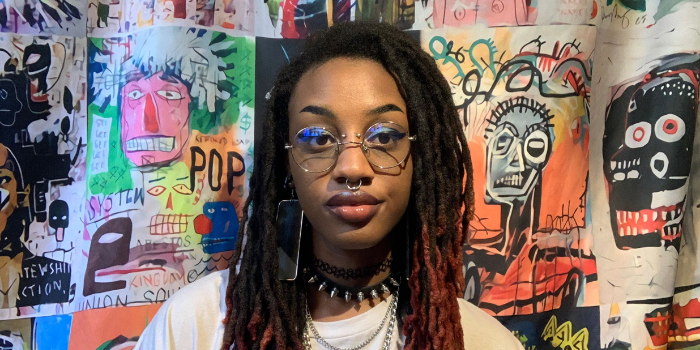
Barely out of college, Ayeola Omolara Kaplan has been surprised at the demand not only for her provocative visual art, but also for her perspective as a Black Jew in America. Kaplan, 23, a painter and illustrator, has been featured in Jewish publications and she spoke about the relationship between her art and her activism at a panel at the 2020 Gershman Philadelphia Jewish Film Festival. In October, she and her art are slated to appear at the Suncoast Black Arts Collaborative in Bradenton, Fla., an event highlighting art and racial justice.
“It’s been mostly Jewish people, Jewish feminists, who have been supportive,” said Kaplan, a 2021 graduate of the New College of Florida who today lives in her hometown of Atlanta. “That surprised me because growing up, I felt a little on the outside. I was the only Black girl in Jewish spaces.”
Kaplan is part of a generation of Black Jewish women, many of them Millennials or Gen Xers, who are using art—paintings, drawings, multimedia works and film—to share and explore their multiethnic perspectives. She and others, including filmmaker Rebecca S’manga Frank and sculptor and multimedia artist Olivia Guterson, are doing so at a moment when Jewish attention is trained on diversity within the Jewish community, an issue amplified by last year’s murder of George Floyd in Minneapolis and the ensuing national conversation around social and racial justice.
These young artists’ productions often feature Black themes more prominently than Jewish motifs. “I think there’s a lot more demand for work that deals with the Black experience than for art about the Jewish experience,” asserted Sarah Anita Clunis, curator of African Collections at the Peabody Museum of Archaeology and Ethnology at Harvard University.
Part of that has to do with heightened racial awareness. But Clunis, who was born and raised in Jamaica by a Sephardic Jewish mother and a father of African ancestry, also notes the traditional Jewish religious prohibition against representational art. Historically, Jewish-themed art was more likely to be Judaica—decorative ritual objects and illuminated manuscripts—rather than fine art or portraiture. In addition, prior to the 20th century, which saw a profusion of secular Jewish artists like Marc Chagall and Mark Rothko, relatively few Jews had prominent artistic careers.
In contrast, Clunis said, “there is a vibrant African tradition of creating representational art,” which extends to the murals found in many Black communities and the street art associated with hip-hop culture. Indeed, the figures in Kaplan’s paintings are representational on multiple levels; her works feature Black civil rights activists Malcolm X and Angela Davis as well as figures—often nude women—advocating for social and political issues, including Black Lives Matter, legalizing marijuana and prison reform.
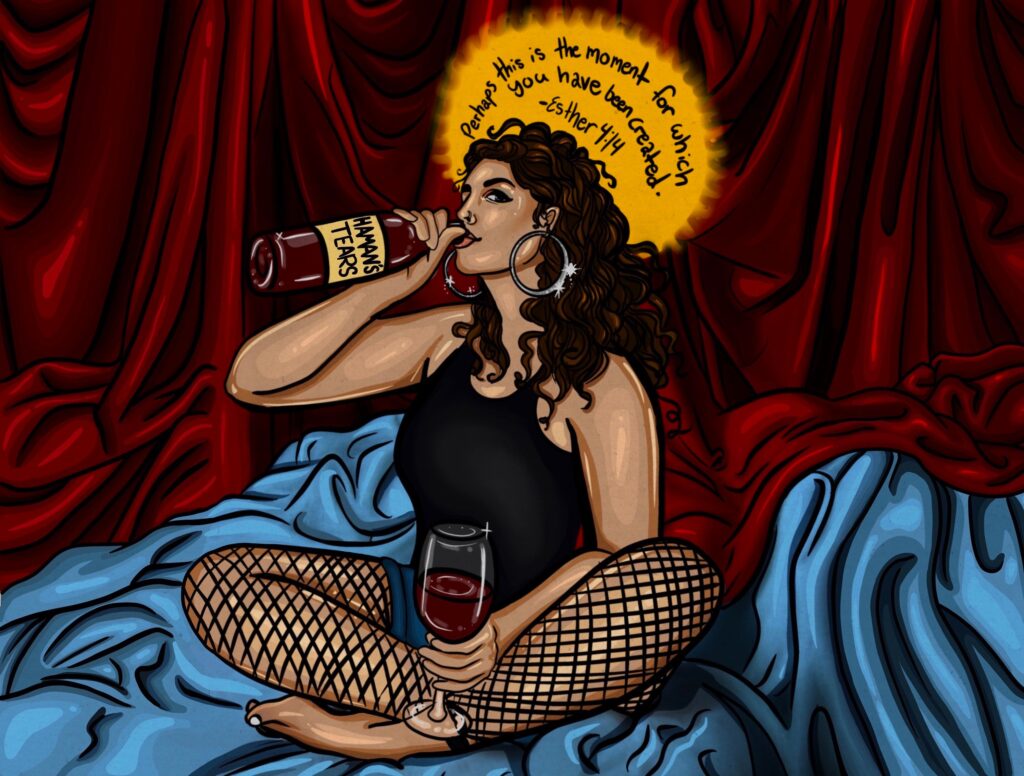
Kaplan (ayeola.org) emphasizes her message using saturated hues, curved lines, bold iconography and accompanying text—a style reminiscent of tattoo and street art. In “It Is Right to Rebel,” for example, a sword (emblazoned with the word “reparations”) and serpentine tails adorn a woman wearing a face mask who has a Star of David on her forehead, a partial self-portrait of the artist. “No Justice, No Peace, No Racist Police” says a swirl around her head.
“I never create anything just to be beautiful. I want it to say something,” explained Kaplan, who grew up in a Reform Jewish community. While Kaplan’s Black references are ubiquitous and explicit, the Star of David shows up in several other pieces, too. And paintings like Queen Esther—portraying the Purim heroine in hoop earrings and fishnet stockings, guzzling wine labeled “Haman’s Tears”—draw on her Jewish upbringing.
Kaplan was inspired to sketch as a child by Japanese anime. But it wasn’t until college that she refined a style that combines activism with Jewish spirituality. In a class on Judaism and ecology, Kaplan had an epiphany about the way Judaism cherishes the natural world. “I’m inspired by the way religion plays into social justice movements,” she said. “Fighting for a better world doesn’t have to be a secular act.”
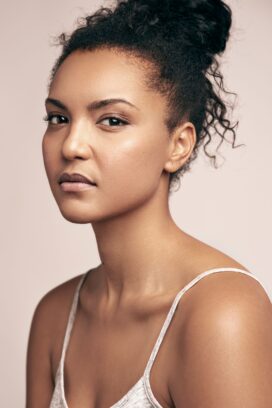
Rebecca S’manga frank (rebeccasmangafrank.com) can also recall the moment her Black and Jewish identities crystallized in her art. The 33-year-old spent six months in 2019 at the Oregon Shakespeare Festival, where she was cast for the first time as a Jewish character, the dual role of Manke, the Jewish prostitute and love interest, and Dorothee, the actress who plays her, in Paula Vogel’s play Indecent, about the production of Sholem Asch’s 1918 Yiddish play God of Vengeance. In rehearsal, recalled the filmmaker and actor who lives in the Crown Heights section of Brooklyn, she “told Jewish stories for the first time. There was lots of interaction with the local Jewish community; we’d have Shabbat dinners together.”
It was Frank’s first engagement with Jewish life since her bat mitzvah almost 20 years earlier. She grew up in Santa Monica, Calif., with her Ashkenazi Jewish mother, a University of Southern California professor who had separated from Frank’s father, a linguist and diplomat from the Kingdom of Eswatini (formerly Swaziland).
Frank’s theater work shifted into film during the pandemic. This spring, as a 2020-2021 New Jewish Culture fellow in the arts organization Brooklyn Jews, Frank filmed an adaptation of S. Ansky’s The Dybbuk, which she titled My Blewish Wedding, using themes in the classic Yiddish play about the possession of a young woman by the soul of a dead person to process her feelings about police violence. The film is slated to be shown by Brooklyn Jews in February 2022.
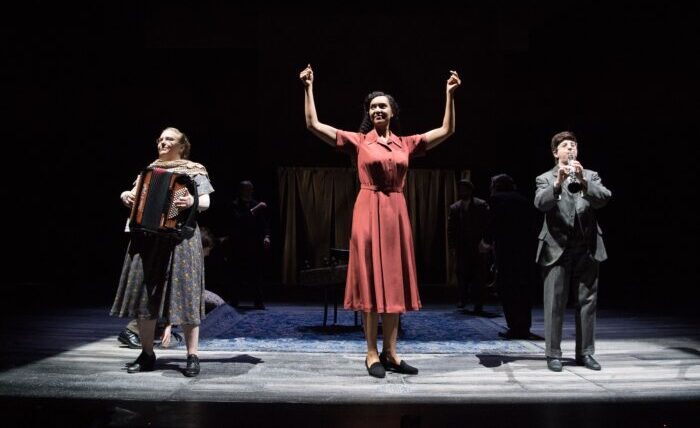
Frank’s film explores the death of Elijah McClain, a Black man who died after a 2019 encounter with the police. Elijah is the “dead soul” who possesses a woman on her wedding day. Similar to The Dybbuk, this ultimately leads to a trial between the living and the dead—inspired by the trial of Derek Chauvin, convicted for killing George Floyd. Frank recalled “waiting for the verdict, like the Jews waiting for the Ten Commandments at Sinai,” she said.
Frank is also a fellow at LABA: A Laboratory for Jewish Culture at New York’s 14th Street Y, where she is developing a performance piece about relationships through the lens of Jewish texts, starting with Eve.
“I used to be pretty much the only Black Jew I knew. Now that’s changing,” said Frank, who has found peers through the online community Black Jewish Liberation Collective and through Ammud, a Jewish educational organization for Jews of Color. “I’m being seen through my art instead of as a token. And I can help make that bridge because I am one.”
The intricate lattices of black and white in Olivia Guterson’s paintings and sculptures reference not only her biracial parentage, but also both her maternal grandmother’s Hebrew-embroidered lacework and the filigree brooches Guterson saw at Black churches growing up.
“I think there’s so much complexity in black and white, and the expanse of what’s in between,” explained Guterson, 30, who lives in Detroit. High contrast art, she noted, also requires greater “precision, intentionality and focus.”
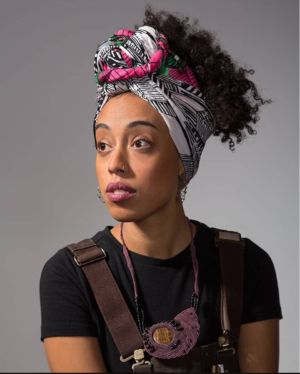
Those qualities have been evident in her art since she left a series of corporate jobs to focus on painting two years ago. She has exhibited at Art Week Miami, Detroit’s Shinola Hotel and ROI gallery in Jerusalem. Her murals grace both indoor and outdoor spaces around Detroit. Guterson (midnightolive.com) has also completed several notable projects for the Jewish arts and culture organization Reboot, including an oversized illuminated menorah and last year’s installation “At Our Table” at the Museum of Contemporary Art Detroit. The latter reimagined, in single-use plastics, the Passover table Guterson grew up with—contrasting the renunciation of bread and plastic as contemporary staples of life.
Guterson’s African-American Catholic mother and Ashkenazi Jewish father met in their native Seattle, raising their daughter with both religious traditions. As a child on the New Mexico Navajo reservation where her father taught, she was immersed in the stimulating local culture. “The Southwest has so many incredible landscapes, plants and textile patterns,” said the self-taught artist. “And because it was so poor, community was vital.”
Today, Guterson said, her work reflects the commonalities she observed as a child of a hybrid background. “How these pieces connect is a part of me,” she reflected. “And art is how I can incorporate all that.”
Hilary Danailova writes about travel, culture, politics and lifestyle for numerous publications.










 Facebook
Facebook Instagram
Instagram Twitter
Twitter
Judith C. Levine says
Happily, we come in every colour. I enjoyed the chance to meet several more of my fellow Jewish artists. I also am sharing this with other art and Jewish groups as I’d like them to learn about these talented artists too.
William Bursie says
Pharaoh Akhenaten, Father of All Three Major Belief.
Miriam Esther Gillman says
I found this article to be quite interesting, yet disappointing. There are observant Afro-Jews whose accomplishments were overlooked..The Chabad Francis family is fascinating. They are one of numerous families who are Torah Jews. I was highly offended by the picture of Esther who was portrayed as a drunken whore. SHAME! The Jews she saved were more than likely (Persia=Sephardic) darker of complexion. Please be apprised that the Afro-Jewish community have Torah observant Jews and their stories!!!